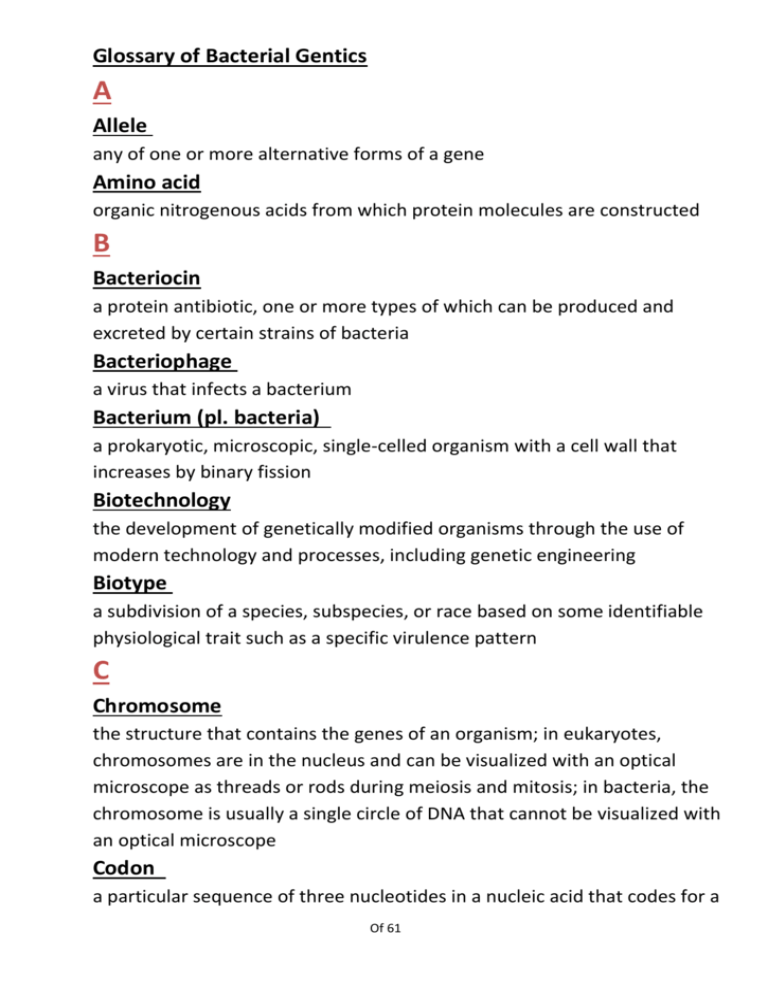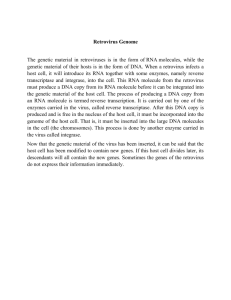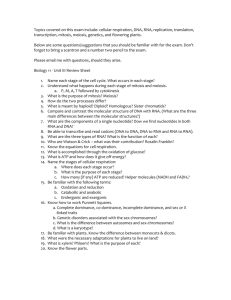Glossary of Bacterial Genetics
advertisement

Glossary of Bacterial Gentics A Allele any of one or more alternative forms of a gene Amino acid organic nitrogenous acids from which protein molecules are constructed B Bacteriocin a protein antibiotic, one or more types of which can be produced and excreted by certain strains of bacteria Bacteriophage a virus that infects a bacterium Bacterium (pl. bacteria) a prokaryotic, microscopic, single-celled organism with a cell wall that increases by binary fission Biotechnology the development of genetically modified organisms through the use of modern technology and processes, including genetic engineering Biotype a subdivision of a species, subspecies, or race based on some identifiable physiological trait such as a specific virulence pattern C Chromosome the structure that contains the genes of an organism; in eukaryotes, chromosomes are in the nucleus and can be visualized with an optical microscope as threads or rods during meiosis and mitosis; in bacteria, the chromosome is usually a single circle of DNA that cannot be visualized with an optical microscope Codon a particular sequence of three nucleotides in a nucleic acid that codes for a Of 61 specific amino acid or termination of a polypeptide chain (see triplet codon) Conjugation the temporary contact of bacterial cells during which genetic material is transferred D Deoxyribonucleicacid (abbr. DNA) the double-stranded, helical molecule that contains genetic code information; each repeating unit, or nucleotide, is composed of deoxyribose (a sugar), a phosphate group, and a purine (adenine or guanine) or a pyrimidine (thymine or cytosine) base. G Gene unit within an organism controlling heritable characteristics; genes are organized on chromosomes Genome the complete genetic information of an organism or virus Genotype genetic constitution of an individual or group; class or group of individuals sharing a specific genetic makeup (see phenotype) Genus (pl. genera) a taxonomic category that includes a group of closely related (structurally or phylogenetically) species; the genus or generic name is the first name in a Latin binomial M Messenger RNA (abbrev. mRNA) a form of RNA that carries information to direct the synthesis of protein. Mutation (n. mutant) an abrupt heritable or genetic change in a gene or an Of 62 individual as a result of an alteration in a gene or chromosome, or of an increase in chromosome number. N Negative-sense RNA (-RNA) ribonucleic acid complementary to the positive or plus sense; not translated into protein (contrasts with positive-sense RNA) Nucleic acid genetic material of all living organisms, including DNA (deoxyribonucleic acid) and RNA (ribonucleic acid) Nucleoid region in prokaryotes, chloroplasts, and mitochondria where the DNA is concentrated. Unlike a nucleus, it is not bound by a membrane. Nucleus dense aggregation of proteinaceous matter and nucleic acid in cells, surrounded by a membrane; contains chromosomes and controls heredity Nucleotide a subunit of a nucleic acid, either DNA or RNA O Open reading frame portion of a nucleic acid molecule that is translated into a protein. P PCR (acronym for polymerase chain reaction) a technique used to amplify the number of copies of a specific region of DNA in order to produce enough of the DNA for use in various applications such as identification and cloning Plasmid a circular, self-replicating hereditary element that is not part Of 63 of a chromosome; plasmids are used in recombinant DNA experiments as acceptors and vectors of foreign DNA Positive-sense RNA (+RNA) RNA that can serve directly as messenger RNA (contrasts with negative-sense RNA). Primer small fragment of nucleic acid with a free 3'-hydroxyl group necessary for initiation of DNA and, sometimes, RNA synthesis; often specific fragments chosen for use in polymerase chain reaction (PCR) for rapid identification of pathogens pv. (abbrev. for pathovar) a subdivision of a plant pathogenic bacterial species defined by host range; pathovar for bacteria is equivalent to forma specialis for fungi. R Race subgroup or biotype within a species or variety, distinguished from other races by virulence, symptom expression, or host range, but not by morphology Recombinant DNA DNA molecules in which sequences, not normally contiguous, have been placed next to each other by in vitro methods Replication the process by which a DNA or RNA molecule makes an exact copy of itself; repetition of an experiment or procedure at the same time and place (one of several identical experiments, procedures, or samples); the process by which a virus particle induces the host cell to reproduce the virus Of 64 Restriction endonuclease enzyme that cleaves DNA at a particular base sequence; sometimes informally referred to as a restriction enzyme Reverse transcriptase enzyme used to make complementary DNA from a piece of RNA, such as a plant virus genome Ribosomal RNA (abbrev. rRNA) RNA molecules forming part of the ribosomal structure. Ribosome a subcellular protoplasmic particle, made up of one or more RNA molecules and several proteins, involved in protein synthesis. RNA (acronym for ribonucleic acid) several nucleic acids composed of repeating units of ribose (a sugar), a phosphate group, and a purine (adenine or guanine) or a pyrimidine (uracil or cytosine) base; transcribed from DNA and involved in translation to proteins. rRNA (abbrev. for ribosomal RNA) RNA molecules forming part of the ribosomal structure. S Species any one kind of life subordinate to a genus but above a race; a group of closely related individuals of the same ancestry, resembling one another in certain inherited characteristics of structure and behavior and relative stability in nature; the individuals of a species ordinarily interbreed freely and maintain themselves and their characteristics in nature. T Transduction the transfer of genes from one organism to another by viruses, especially in bacteria. Of 65 Transfer RNA (abbrev. tRNA) the RNA that moves amino acids to the ribosome to be placed in the order prescribed by the messenger RNA. Transformation the transfer of genetic materials from one organism to another by humans (genetic engineering); a means of genetic variation in bacteria by absorption and incorporation of DNA from another bacterial cell. Transgenic possessing a gene from another species; used to describe the organisms that have been the subject of genetic engineering (see also genetically modified organism, GMO). Translation the assembling of amino acids into a protein using messenger RNA, ribosomes and transfer RNA. Triplet codon a set of three nucleotide bases in DNA or RNA that code for an amino acid. Type the example on which the description of a scientific name is based, and which fixes the application of the name (the type genus of a family, or the type species of a genus). American Phytopathological Society (APS) Illustrated Glossary of Plant Pathology Authors: C.J. D'Arcy, D.M. Eastburn, and G. L. Schumann (with acknowledgement of contributions from M.C. Shurtleff, P.A. Arneson, F.H. Tainter, and T.A. Evans) http://www.apsnet.org/edcenter/illglossary/Pages/default.aspx Of 66






